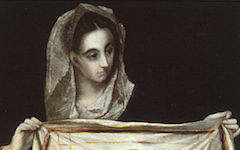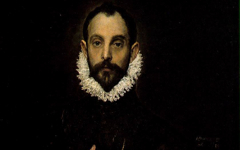El Greco’s Purification of the Temple (c.1570-1610)
While on his odyssey from Greece to Toledo through the art centers of Venice and Rome the young El Greco painted a scene of Christ clearing the Temple in which he borrowed figural poses from Italian masters. He then painted a very similar version of the same scene (below) in which four artists appear in the lower right corner: Titian, Michelangelo, his mentor Giulio Clovio and, perhaps, in the corner itself Raphael.

El Greco, Purification of the Temple (early- to mid-1570's) Oil on canvas. Minneapolis Institute of the Arts
Click image to enlarge.
Some think the "Raphael" is El Greco which is more likely for one significant and overlooked fact: the figure in the corner resembles Christ in the center. Just as Mantegna, Dürer, Titian and other Renaissance masters identified with Christ, as shown in large part for the first time on this site, so did El Greco.1 Either way El Greco was thinking esoterically in Christomorphic terms as he would have done earlier as an icon painter in Greece.
Click next thumbnail to continue

Detail of El Greco's Purification of the Temple (early- to mid-1570's) Minneapolis
Click image to enlarge.
El Greco's Christ is a kind of mirror-image of the figure he is whipping, both with their right arms bent and raised and with the palm of their left hand open. Christ is the "artist" whipping (ie., painting) a version of himself into shape. It is a motif that remains more or less constant through all four versions and explains why, in this version, El Greco signed his name on the stone step, not centered under Christ as you might expect, but left of center directly between Christ and his victim. It underlines both the self-reference and the link between the two figures: the suffering artist on the left will become like Christ on the right.
Click next thumbnail to continue
The basic paradigm of art, that every painter paints himself, is important because it is universal. We all paint our own reality by seeing the world as a reflection of what we are. So, amusingly, did the curators of an El Greco exhibition in New York in 2003. They explained the four artists at left as though El Greco, like them, was an academic. "The artists are not meant to be bystanders to the scene", the catalog noted, but "their insertion is similar in character to a textual footnote crediting the sources employed in the main text."2 I take their presence more seriously to indicate that the scene above them takes place in an artistic mind common to them all. The artistic mind, like our own without illusions, is universal.
Click next thumbnail to continue

El Greco, Purification of the Temple (c.1570-1) Oil on poplar panel. National Gallery of Art, Washington, DC
Click image to enlarge.
In the first of the series (left) an old man resembling Titian looks up towards Christ (as in Titian's late Pietà.) The figure, its identity unknown, has been criticized for not fitting easily into its space. He is seated but not apparently on the stone step, a spatial "error" put down to El Greco's inexperience. It is possible, though, that "Titian" sits in his studio while also being part of the scene, a figure intended to bridge two realities. In the next version (prior image) he added the portraits to suggest the studio space more emphatically while making the figure fit into the scene. Thus, in either version, we see creation in the artist's mind, a mental "studio" where the artist both makes the art and is the art.
Click next thumbnail to continue

El Greco, Purification of the Temple (c.1600) Oil on canvas. National Gallery, London
Click image to enlarge.
Two decades later El Greco refined the scene, the figures now fitting more comfortably into the overall composition. Nevertheless, the old man no longer resembling "Titian" still sits oddly, his left leg strangely seen from above, his torso seen in profile.3 By this means, the figure continues to bridge the two realities, that of the studio floor (horizontal and close to the lower edge) and that of the canvas (vertical and from his waist up). A table, knocked over, might also be read as a studio table near the real artist outside.4
See conclusion below
Once again we have a painting like Edouard Manet's Mlle V in the Costume of an Espada that fuses the studio with the artwork. It leaves us to perceive the 3-dimensional foreground figures as in the studio while the figures higher up the canvas appear flat and vertical like the canvas itself. Time and again Manet and other artists used the same recipe. Most of the examples already explained on the site occurred in nineteenth-century Paris but their concepts were not modern, as so long believed, but learnt from the many masters of the Renaissance including El Greco.
More Works by El Greco
Notes:
1. There is a possibility that El Greco was using Raphael as his alter ego but I think that unlikely in the presence of Michelangelo and Titian.
3. The old man has been identified as St. Peter based on his "characteristic physiognomy" and the yellow and blue of his robes, described as "canonical colors." New York 2003, El Greco, p. 92
4. Cézanne and Matisse are two nineteenth-century artists who are part of that tradition as is shown, or will be shown, on this site.
Original Publication Date on EPPH: 26 May 2012. | Updated: 0. © Simon Abrahams. Articles on this site are the copyright of Simon Abrahams. To use copyrighted material in print or other media for purposes beyond 'fair use', you must obtain permission from the copyright owner. Websites may link to this page without permission (please do) but may not reproduce the material on their own site without crediting Simon Abrahams and EPPH.



